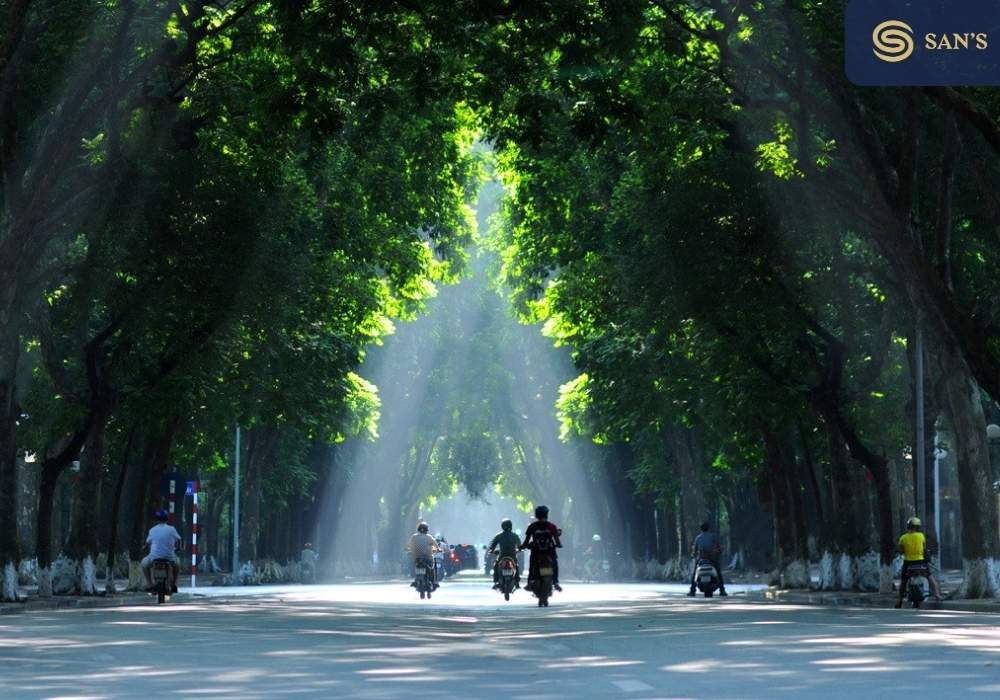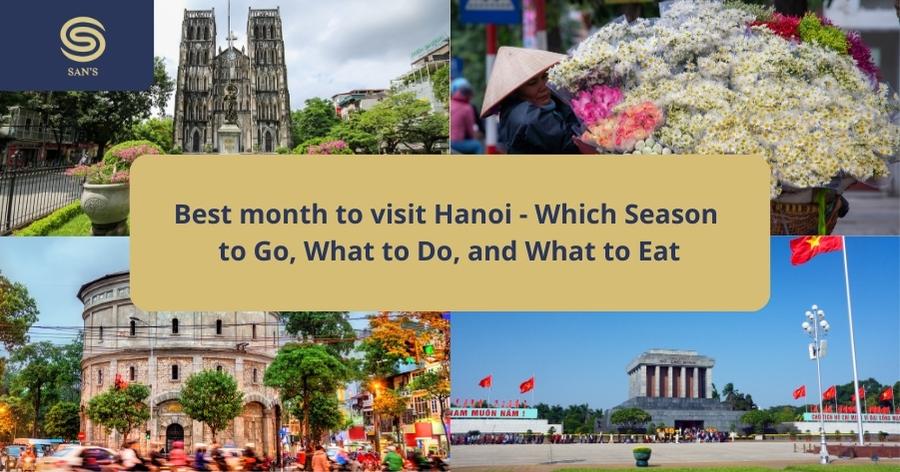Vietnam, a gem in Southeast Asia, boasts a rich tapestry of cultures, landscapes, and experiences. This beautiful country can be an enigma for travelers seeking the perfect time to explore its vast wonders. Identifying the best time to visit Vietnam can be a complex task, with regional climates varying significantly. This guide is tailored to help you navigate through the country’s seasons and festivities, ensuring you enjoy the best time to visit Vietnam has to offer.
1/North Vietnam – Hanoi, Sapa, Halong Bay
The Harmony of Seasons
The North, characterized by its dramatic landscapes and rich history, offers distinct experiences through the year.
Winter (December to February)
-

The Best Time to Visit Vietnam
-

The Best Time to Visit Vietnam
>>> See more: Hanoi Old Quarter Hotel
Winter’s cool climate is the best time to visit Vietnam for leisurely exploration of Hanoi’s street markets, museums, and landmarks. Sapa’s chilly but clear weather gives you the chance to hike amidst snow-capped mountains.
Summer (June to August)
Summer provides a vibrant, albeit humid, setting to explore Halong Bay’s emerald waters and mysterious caves.
Food and Festivals
Winter Delicacies: Warm up with ‘Pho,’ a traditional Vietnamese soup that’s particularly enjoyable in winter.
Hanoi’s Winter Festival: A lesser-known celebration that fills the streets with music, dance, and local crafts.
2/Central Vietnam – Hue, Da Nang, Hoi An
A Mix of Culture and Beaches
Central Vietnam’s combination of history, culture, and stunning coastlines means timing is essential, especially for travelers seeking to immerse themselves in the region’s rich heritage.
Spring (February to May): Spring is often considered the best time to visit Vietnam’s UNESCO World Heritage Sites like Hue’s Imperial City and Hoi An’s Ancient Town. The moderate temperatures and low rainfall during this period create a comfortable setting for exploration.
In Hue, the Imperial City stands as a monument to Vietnam’s historical significance, showcasing majestic palaces, ornate temples, and ancient fortifications. Spring’s pleasant weather allows visitors to walk through the sprawling complex, appreciating the intricate architecture and vibrant gardens without the hindrance of summer’s stifling heat or winter’s chill.
-

Hue’s Imperial City – The Best Time to Visit Vietnam
Hoi An’s Ancient Town, on the other hand, comes alive in the gentle warmth of spring. The streets, lined with well-preserved merchant houses, beckon travelers to wander and discover hidden courtyards, colorful lanterns, and lively markets. Spring also hosts various cultural festivals in Hoi An, such as the Lantern Festival, where locals and tourists alike can participate in releasing lanterns into the river, creating an enchanting spectacle of floating lights.
-

Hoi An’s Ancient Town – The Best Time to Visit Vietnam
Moreover, spring is the season when many tropical fruits and local produce are at their peak, giving food enthusiasts an excellent opportunity to savor the unique flavors of Central Vietnamese cuisine. From sipping freshly brewed local tea to tasting traditional dishes like ‘Banh Beo’ (steamed rice cakes) and ‘Bun Bo Hue’ (Hue beef noodle soup), the culinary experiences are endless.
3/South Vietnam – Ho Chi Minh City, Mekong Delta
Tropical Wonders
Dry Season (December to April):
Considered the best time to visit Vietnam’s southern region, the dry and cool weather makes city exploration and river cruising particularly enjoyable. The streets of Ho Chi Minh City become lively with bustling markets, vibrant street art, and open-air cafes, where you can soak in the city’s modern vibe. River cruises on the Mekong Delta turn into unforgettable journeys, where you can explore floating markets, traditional crafts, and idyllic rural life. The clear skies and moderate temperatures offer a perfect backdrop for outdoor activities such as cycling and kayaking.
Wet Season (May to November):
While often overlooked, the wet season has its unique charm. Short daily rains enhance the lush landscapes of the Mekong Delta, turning it into a photographer’s dream. The vibrant greenery, reflecting off the calm waters, provides stunning visual contrasts. This season also brings life to waterfalls and natural springs in the region, offering unique outdoor experiences. While rain may occasionally interrupt outdoor activities, it often adds a refreshing touch to the hot and humid climate.
Cultural and Culinary Experiences
War Remnants Museum, Ho Chi Minh City: Explore Vietnam’s history; this indoor attraction can be visited at any time of the year.
Street Food Tours: Indulge in the South’s diverse flavors, especially enjoyable in the cool dry season.
4/Festivals and Culinary Exploration
Tet Festival (Late January to Early February): The Tet Festival is Vietnam’s New Year celebration, marking the arrival of spring according to the lunar calendar. It’s the best time to visit Vietnam to experience the joy, rituals, and traditional foods. Streets come alive with decorations, fireworks, and parades. Families gather for special meals featuring dishes like ‘Banh Chung’ (sticky rice cake) and ‘Goi Cuon’ (spring rolls). Temples and pagodas are bustling with activities, and markets offer unique Tet gifts and ornaments.
-

Tet Festival – The Best Time to Visit Vietnam
Mid-Autumn Festival (September): A magical festival where families gather to celebrate with mooncakes, colorful lanterns, and enchanting lion dances. Children carry lanterns through the streets, and communities host lively performances. It’s a heartwarming occasion to be part of, reflecting Vietnam’s rich cultural heritage.
-

Mid Autumn
Hue Festival (April to June): This biennial festival in Hue celebrates Vietnamese traditional culture and arts. It’s a kaleidoscope of performances, exhibitions, and historical recreations, turning the city into a vibrant cultural hub.
-

Hue Festival – The Best Time to Visit Vietnam
Seasonal Culinary Delights
Fruit Harvest Seasons: Timing your visit to coincide with fruit harvest seasons is a delightful way to enjoy fresh tropical fruits like mangosteens, lychees, rambutans, and durian. Local markets burst with colors and aromas, and fruit farms often welcome visitors to pick their treats. Each region in Vietnam offers unique fruit specialties, making it an exciting exploration throughout the country.
Seafood Seasons: Coastal regions of Vietnam are seafood paradises. Visiting during peak fishing seasons, especially in places like Nha Trang and Phu Quoc, ensures the freshest catch. Whether it’s enjoying grilled squid by the beach or a lavish seafood hotpot, the culinary experiences are bound to be memorable.
Street Food Adventures: Vietnam’s street food culture is an unending exploration of flavors and techniques. From North to South, each region has its unique street food scene. Tasting seasonal specialties, such as ‘Bun Thang’ (chicken noodle soup) in Hanoi’s winter or ‘Banh Xeo’ (sizzling pancakes) in Saigon’s summer, offers an authentic taste of local life.
5/Practical Tips for Travelers
Health Precautions
Vaccinations: Before embarking on your trip, consult with your healthcare provider regarding recommended vaccinations and travel health precautions. Common travel vaccines for Vietnam may include Hepatitis A, Typhoid, and Tetanus. Ensuring you’re properly immunized will give you peace of mind while exploring this beautiful country.
Medications and Travel Insurance: Carry any necessary medications and a basic first-aid kit. It’s also wise to consider comprehensive travel insurance that covers medical emergencies. Knowing you’re protected allows you to enjoy your trip without unnecessary worry.
Water and Food Safety: The best time to visit Vietnam can also be affected by local food and water conditions. Drinking bottled or treated water and eating well-cooked food from reputable sources will minimize risks.
Accommodations and Transport
Early Bookings: During peak travel seasons, especially around significant festivals and holidays, accommodations and transportation can fill up quickly. Early bookings will secure better rates, choices, and locations. Consider researching and booking your stay and transport at least a few months in advance.
Local Transport Options: Vietnam offers various transport options, including trains, buses, taxis, and bike rentals. Familiarizing yourself with these options and their safety standards will enhance your travel experience. Apps like Grab can be handy for taxi services in major cities.
Special Interest Travel
Adventure Activities: Whether it’s trekking in Sapa, biking in Hue, or diving in Nha Trang, each adventure activity has its own optimal season. Researching and planning accordingly will ensure the best experience. Reputable tour operators often provide detailed information and necessary safety measures.
Shopping and Bargains: Vietnam’s markets are famous for their diversity and bargains. Seasonal sales, especially during local holidays like Tet, can score you great deals. Markets like Ben Thanh in Ho Chi Minh City or Dong Xuan in Hanoi offer unique shopping experiences. Bargaining is common, so don’t hesitate to negotiate prices with a friendly attitude.
Responsible Travel: Being mindful of local customs and the environment is vital. Respect religious sites, reduce plastic usage, and support local communities by choosing responsible travel operators and products.
The best time to visit Vietnam is not a one-size-fits-all answer. Your preferences, interests, and the regions you want to explore will play a vital role in determining the optimal time for your visit. This guide has strived to present a well-rounded view of what Vietnam has to offer throughout the year, in different locations. By understanding the climate, festivals, and local attractions, you can craft an itinerary that’s perfect for you.
So pack your bags and get ready to dive into the mesmerizing world of Vietnam, where every moment is filled with discovery, wonder, and joy. Whether it’s the stunning landscapes of Halong Bay or the historic charm of Hoi An, the best time to visit Vietnam is whenever your heart calls you to this land of endless enchantment.
>>>See more: Thing to do at Hanoi Old Quarter





